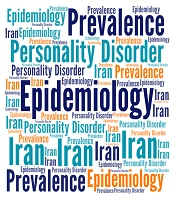Dear editor
Personality disorders (PDs) are one of the most common psychiatric problems worldwide (1). In addition to morbidity and mortality, these disorders can lead to numerous high-risk behaviors such as risky driving, alcohol abuse, substance addiction, delinquency, violence, suicide, and homicide (2). Although the epidemiological data are necessary to provide comprehensive treatment systems and health policies in this area, in Iran, as a multi-ethnic and multi-cultural country, a few epidemiological studies are available for PDs. Several studies have reported the prevalence of PDs among psychiatric outpatients and inpatients at approximately 6 -81% (3, 4) and 8 - 68% (5-8), respectively. The most common diagnostic categories among inpatients were borderline (BPD; up to 61%), paranoid (PPD; up to 48%), and narcissistic (NPD; up to 38%), while outpatients mostly suffer from narcissistic (NPD; up to 57%), obsessive-compulsive (OCPD; up to 39%), and histrionic (HPD; up to 35%). Other studies have reported an overall prevalence of PDs among drug addicts as 14 - 56% (7, 9-14). Concerning this population, the highest prevalence rate is associated with anti-social (ASPD; up to 75%), HPD (up to 42%), and NPD (up to 40%). The same three diagnostic categories have the highest prevalence among prisoners (ASPD up to 86%, HPD up to 54%, and NPD up to 41%; overall prevalence up to 56%) (15-17).
Personality disorders are also relatively common psychiatric conditions in the non-psychiatric population (overall 27 - 41%). According to several reports (18-20), NPD (up to 15%), ASPD (up to 14%), and avoidant (APD; up to 12%) are the most common disorders in this population. Several other studies point to lower prevalence rates in general adult and adolescent populations (21-30). According to these reports, the overall prevalence of PDs in the general population of adults and adolescents was 20% and 17%, respectively. The most common diagnostic categories in adults were OCPD (up to 4%), and NPD, and BPD (up to 3%) (21-26), while OCPD and APD (up to 10%) and BPD (up to 8%) were the most common disorders in adolescents (27-30). In the general population of adults and adolescents, although the established diagnosis of PDs is less common, clinically significant personality traits or threshold PDs are remarkable (35% and 37%, respectively).
According to the above considerations, it seems that psychiatric therapists and clinicians need to screen PDs comorbidity with other psychiatric disorders in the initial evaluation of patients. Given the resistance of PDs to psychotherapy and pharmacological therapies, neglecting these disorders in the initial assessment can be a serious obstacle to the successful treatment of other psychiatric conditions. On the other hand, we found that more than one-third of the general population of adults and adolescents are exposed to threshold PDs. Even if the epidemiologic data obtained in the reported studies are somewhat biased due to the use of self-report tools such as Millon Clinical Multiaxial Inventory (MCMI), the epidemiological findings summarized in the current report do not diminish the importance of screening, diagnosing, and treating the symptoms of these disorders in Iranian clinical and general populations. However, future studies can provide more valuable results with a focus on population-based nationwide epidemiological surveys using more valid tools.
